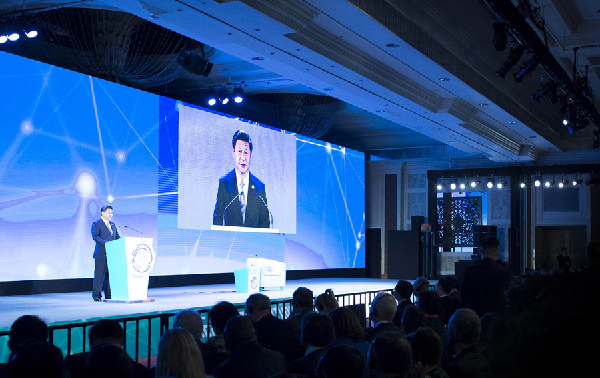Belt and Road initiative to strengthen Asia-Pacific economic integration

Chinese President Xi Jinping addresses the APEC CEO summit in Manila, the Philippines, Nov. 18, 2015. (Xinhua/Wang Ye)
MANILA, Nov. 18 (Xinhua) -- Regional economic integration and cooperation is the focus of the 2015 Asia-Pacific Economic Cooperation (APEC) Economic Leaders' Meeting, which kicked off in the capital city of the Philippines on Wednesday.
China's Belt and Road initiative will also be in the spotlight of the meeting as Chinese President Xi Jinping, who proposed it in 2013 with the aim of booting regional integration and connectivity, is expected to introduce the progress made in implementing initiative and the opportunities it brings to the region and the world.
CHINESE INITIATIVE BOON TO REGIONAL INTEGRATION
As political analysts point out, the economic development of many countries in the Asia-Pacific has been seriously hindered by inadequate infrastructure, but China's initiatives, including the Belt and Road, come as an important solution to the bottleneck.
"That's where the Belt and Road initiative and Asia Infrastructure Investment Bank (AIIB) come in. With ample investment, countries could accelerate infrastructure construction so as to further push forward economic growth," said Benito Lim, political science professor of Ateneo de Manila University.
The Silk Road Economic Belt and the 21st Century Maritime Silk Road (Belt and Road) initiative aims to rejuvenate the two ancient trading routes and further open markets in a mutually beneficial manner.
Since its inception in 2013, the initiative has been widely lauded in Asia, Europe and Africa because it offers numerous opportunities of better life and development to the countries and regions concerned.
At this point, China has already reached agreements with many countries on joining efforts to bolster the ambitious and inspiring initiative that involves more than 60 countries and regions with a total population of 4.4 billion.
On Sunday, Xi and Russian President Vladimir Putin renewed their agreement on aligning China's Belt and Road initiative with the Russia-initiated Eurasian Economic Union in Anatalya, Turkey, where they were attending the 2015 summit of the Group of 20.
During the Chinese president's first state visit to Vietnam earlier this month, the two countries agreed to expand cooperation within the framework of the Chinese initiative.
Similar agreements have been made between China and other countries such as Singapore, Kazakhstan, Mongolia and Malaysia.
China also made headway via the Association of Southeast Asian Nations (ASEAN) 10+1 arrangement, the Shanghai Cooperation Organization as well as the cooperation mechanism of the BRICS countries.
"It is a very unusual pursuit and new strategy that I've never seen before. Through the initiative, China encourages countries to form economic partnership and really promote connectivity and integration," said Lim.

Chinese President Xi Jinping addresses the APEC CEO summit in Manila, the Philippines, Nov. 18, 2015. (Xinhua/Li Xueren)
PLATFORM OPENS FOR ALL
Many observers note that setting no bars for other economies to take part, China's Belt and Road initiative is very open and genuinely invites all other countries for formulating its rules.
The Chinese president has extended his welcome on various occasions for all economies interested in the initiative.
Xi said in March that the Belt and Road and the AIIB are both open initiatives. China welcomes all countries along the routes and in Asia, as well as friends and partners around the world, to actively participate in these endeavors.
He also reaffirmed China's stance on the initiative this month when delivering a speech at the National University of Singapore.
China is willing to jointly implement the Belt and Road initiative with its neighboring countries to achieve common peace and development, he said.
Zhuo Shaojie, deputy director of the Chinese Study Center at the University of Melbourne, said: "China is working hard to facilitate the economic stabilization in Asia and the Pacific, as well as in the world, and has actively participated in the global governance and the building of an open world economy."
MORE VIBRANT ECONOMIC TIES FORGED
Only two years since the initiative was put forward, economic ties in relevant countries and regions have already been greatly promoted.
China's outbound foreign direct investment grew from several billion U. S. dollars in 2004 to around 116 billion dollars last year, making it the world's third-biggest capital exporter.
With the establishment of the AIIB, the New Development Bank of BRICS, and the new Silk Road Fund, China is diverging its investment into emerging economies instead of just developed countries.
Official Chinese figures show that Chinese enterprises invested in 48 countries along the Belt and Road last year. Their investment went up 66percent year on year to 12.03 billion dollars and mainly in Singapore, Kazakhstan, Laos, Indonesia, Russia and Thailand.
Meanwhile, countries and regions along the Belt and Road invested 6.12 billion dollars in China in the first three quarters of 2015, up 18.4 percent year on year. They invested in and established 1,604 enterprises in China, up 19 percent year on year.
The APEC summit, a platform for members to share experience and help each other solve economic problems, is a great occasion for leaders of the member economies to push forward the Chinese initiatives so as to realize the APEC Connectivity Blueprint 2015-2025.
The blueprint, approved at the APEC summit in Beijing last year to lay the foundation for all-round connectivity in the Asia-Pacific region, involves the construction of new roads, railways and shipping lanes; the slashing of regulatory constraints; and the easing of barriers to people-to-people interaction and mobility.


